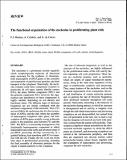Por favor, use este identificador para citar o enlazar a este item:
http://hdl.handle.net/10261/211236COMPARTIR / EXPORTAR:
 SHARE
BASE SHARE
BASE
|
|
| Visualizar otros formatos: MARC | Dublin Core | RDF | ORE | MODS | METS | DIDL | DATACITE | |

| Título: | The functional organization of the nucleolus in proliferating plant cells |
Autor: | Medina, F. Javier CSIC ORCID CVN ; Cerdido, Antonio; Cárcer, Guillermo de CSIC ORCID | Palabras clave: | rDNA rRNA Fibrillar center Dense fibrillar component Cell cycle Mitosis Nucleologenesis |
Fecha de publicación: | 2000 | Editor: | PAGEPress | Citación: | Eur J Histochem 44 (2) 117-31 (2000) | Resumen: | The nucleolus is a prominent nuclear organelle which morphologically expresses all functional steps necessary for the synthesis of ribosomes, from transcription of rRNA genes to the assembly and maturation of preribosomal particles and their transport to the cytoplasm. Structurally, the nucleolus contains some basic components common to practically all cell types, namely fibrillar centers (FCs), the dense fibrillar component (DFC), and the granular component (GC); however, the organization and distribution of these components is highly variable, depending on cell identity and functional status. The different steps of ribosome biogenesis are not strictly correlated with the structural components of the nucleolus. Thus, FCs are most likely the anchoring sites for the accumulation of rDNA, and the sites where the assembly of transcription complexes takes place, but transcription of rRNA genes actually occurs at discrete points in the transition zone between FCs and the DFC. The DFC is a structurally homogeneous, but functionally heterogeneous component in which transcription and some early and advanced steps of pre-rRNA processing develop successively in a gradual fashion, from transition with FCs to transition with the GC. Finally, the GC is the site of the later steps of preribosomal processing, including the final assembly of ribosomal proteins for the export of mature particles to the cytoplasm. The rate of ribosome biogenesis, as well as the structure of the nucleolus, are highly influenced by the proliferation status of the cell, and by factors regulating cell cycle progression. These factors are nucleolar proteins, such as nucleolin, which are targets of signal transduction mechanisms, being at the same time regulators of key steps in preribosome synthesis and processing. Thus, many features of the nucleolus, such as the structural organization of its components, the level and distribution of certain nucleolar proteins and, in general, the rate of ribosome biogenesis, show profound variations throughout cell cycle periods. Particularly interesting is the behavior of the nucleolus during mitosis, in which its structure is disorganized and its activity is stopped, even though the individual transcription and processing complexes are not disassembled, but carried from one cell generation to the next one in such a way that the daughter-cell nucleoli are built with materials coming from the parent-cell nucleolus. Transcription complexes remain assembled at the chromosomal nucleolar organizer in which the rRNA genes are clustered, and processing complexes are carried at the chromosome periphery, and then they are organized into discrete entities called prenucleolar bodies, whose fusion, together with the resumption of transcription and processing, originates the new nucleolus. | Descripción: | 15 p.-4 fig. | URI: | http://hdl.handle.net/10261/211236 | ISSN: | 1121-760X | E-ISSN: | 2038-8306 |
| Aparece en las colecciones: | (CIB) Artículos |
Ficheros en este ítem:
| Fichero | Descripción | Tamaño | Formato | |
|---|---|---|---|---|
| Medina_2000_EurJHistochem_review.pdf | Artículo principal | 2,49 MB | Adobe PDF |  Visualizar/Abrir |
CORE Recommender
Page view(s)
152
checked on 22-abr-2024
Download(s)
131
checked on 22-abr-2024
Google ScholarTM
Check
Este item está licenciado bajo una Licencia Creative Commons

